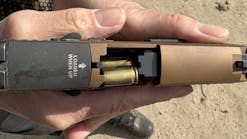Backup To Your Backup
As a Law Enforcement firearms writer, I am always preaching having a backup. This includes having a backup firearm, pre-positioning assets like ambulances and additional units on critical calls and having additional strategies for winning in court. This month is about leveraging two perishable skills into winning strategies: fitness and firearms. Your greatest backup is your health and physical fitness. In fact, it’s a backup to your backup.
The drill for this month—called the Backup Drill—is designed to get the heart pumping while getting in some trigger time. The course itself only takes 18 rounds per run, which allows an officer to run it three times while consuming a little more than a box of cartridges.
Fitness
Physical fitness is a recognized component of preventative medicine, along with rest, nutrition and emotional well-being. There are several kinds of physical fitness: cardio, strength and endurance. All three contribute to maximum oxygen transport, a decrease of body fat, a strengthening of muscles, tendons and bones, an improvement of blood health, and a better balance between oxygen supply and demand.
Law Enforcement fitness has unique demands, such as a need to go from sedentary to “what did I just get into?” Despite our best intentions, we really cannot design a training program for law enforcement officers that could even remotely simulate reality. If we did it realistically, we would need to have dozens of role enactors with no experience as vocal critics strategically placed to impede the officer’s progress.
The strategy to cardio fitness strength is regular endurance interval training. The most recent trend for cardio is HIIT, or high intensity interval training. This strategy is a series of brief, intense work out periods, followed by even briefer rest periods, which get the person outside of their comfort zone. HIIT training can have several strategies, like fat loss and increasing strength and endurance.
The Backup Drill is not a HIIT routine, simply because the training period is too short, but it can be performed in a similar manner. Sprint from point to point, run it three times in a row with a one-minute break, and strive for reduced time in each station. The work intensity should be 85% to 120%. Gauge this by achieving a heart rate of 220 minus (your age), give or take 10%.
If you have a training partner, start this training with simple pushing. That is, for three minutes, lock arms and push each other. The rules are simple: do not disengage, use your full body weight, don’t completely upset the balance of your training partner and do not let up on the pressure at all. If you have not done this before, try it for a full three minutes with another officer. It is a great warm up to any range drill.
Dry Fire
Before doing this drill, I recommend dry firing at home. Most firearm trainers will tell you that a steady routine of dry firing is the key to good marksmanship, especially marksmanship under stress. Dry firing can reinforce good habits and extinguish bad ones. I normally recommend 250 to100 rounds of dry firing per week, which should include holster draws and movement while drawing.
The Backup Drill
I have provided a schematic of this drill. It was designed for a range area that has a minimum of 25 by 25 yards of range floor. The longest shooting distance is about 15 yards. Use the duty belt, and simulate a duty environment. This term has different meanings to different officers, and I encourage incorporating these meanings into the training.
The course has two traffic cones on the far right and left of the range, at least 15 yards apart. Begin on the left cone, which is Position #1. There are four parallel targets, a little further than shoulder width apart, numbered 1 to 4 from left to right. The barricade in the graphic can be a target stand with cardboard, a 50 gallon barrel, or something similar. When we shot this course, we treated the barricade like a vehicle wheel. We put the soles of our shoes against the barricade and fired from a supine position.
When firing supine from the barricade, remember that much of your body is forward of the muzzle of the gun. Do not shoot one of your body parts. Dry fire first, then do a dry run of the course. During the safety briefing, specifically give a warning about not shooting body parts.
Position #3 uses a waist high bar or rope that is parallel to the line of targets. Officers jump over, crawl under and toss the 50-pound bag over the rope or bar. When Officers report to this station, they should start on the target side, and go to the side farthest from the targets. Each time they get to the far side, they fire one shot on Target #2.
The bag in Position #3 can be simply a 50-pound bag of sand. I used an old Army issue duffle bag, with only 50 pounds of sand. This only fills it about a quarter full, which makes it hard to grab and maneuver.
The barricade for Position #3 and Position #4 are all on the 5 yard line.
At the “Threat” command, fire one shot on target #1, holster and run to position #2.
Fire one shout on Target #4, change magazines and holster. Run to Position #1.
From Position #1, fire one shot on Target #1. Holster and run to the barricade. From the left side of the barricade, fire on one round on Target #1 while on your back, one round kneeling and one round standing, using the left hand. From the right side of the barricade, fire one round kneeling and one round standing—using the right hand—on Target #1. Holster and move to Position #3.
From position #3, begin from the side of the bar that is closest to the targets with a holstered gun. Jump over the bar, draw and fire one shot on Target #3. Holster and jump back to the other side. Start on the target side with a holstered gun and crawl under the bar. Draw and fire one shot on Target #2 and holster. Crawl back to the target side. Start with a holstered gun on the target side, throw the bag over, then jump over. Shoot from that side, then throw the bag back. Holster, then jump over.
Move to Position #4. Fire two shots each on targets 2, 3 and 4. Change magazines. Fire two more shots on each target. End of course.
If the last stage at Position #4 sounds familiar, it is not a coincidence. It is just a modified el Presidente.
Modify It
Like any training course, it is important that the agency assess the training need, and modify the training program to meet these needs. This course could be timed, each stage could be timed, or the positions could be changed. For example, the course could be 25 yards, and Positions #3 and #4 could be placed at 15 yards.
Most importantly, stay safe.

Officer Lindsey Bertomen (ret.), Contributing Editor
Lindsey Bertomen is a retired police officer and retired military small arms trainer. He teaches criminal justice at Hartnell College in Salinas, California, where serves as a POST administrator and firearms instructor. He also teaches civilian firearms classes, enjoys fly fishing, martial arts, and mountain biking. His articles have appeared in print and online for over two decades.



